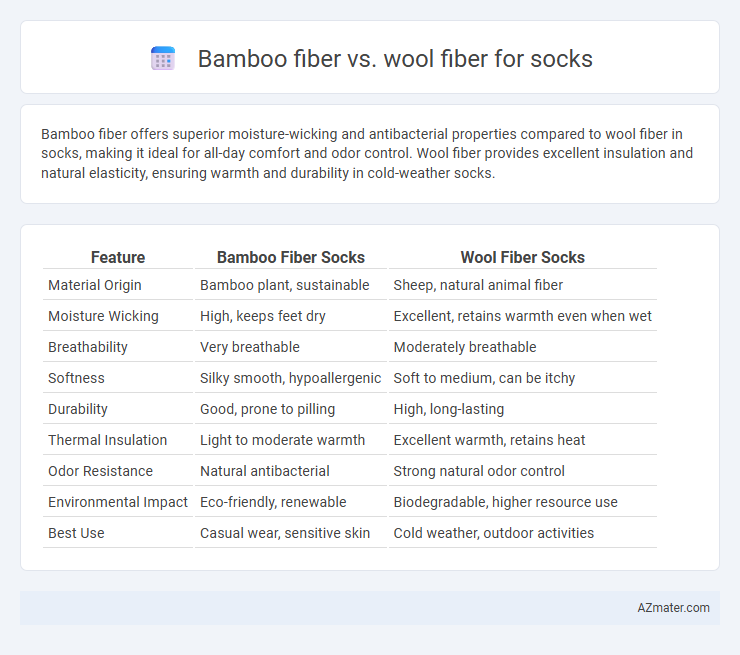Bamboo fiber offers superior moisture-wicking and antibacterial properties compared to wool fiber in socks, making it ideal for all-day comfort and odor control. Wool fiber provides excellent insulation and natural elasticity, ensuring warmth and durability in cold-weather socks.
Table of Comparison
| Feature | Bamboo Fiber Socks | Wool Fiber Socks |
|---|---|---|
| Material Origin | Bamboo plant, sustainable | Sheep, natural animal fiber |
| Moisture Wicking | High, keeps feet dry | Excellent, retains warmth even when wet |
| Breathability | Very breathable | Moderately breathable |
| Softness | Silky smooth, hypoallergenic | Soft to medium, can be itchy |
| Durability | Good, prone to pilling | High, long-lasting |
| Thermal Insulation | Light to moderate warmth | Excellent warmth, retains heat |
| Odor Resistance | Natural antibacterial | Strong natural odor control |
| Environmental Impact | Eco-friendly, renewable | Biodegradable, higher resource use |
| Best Use | Casual wear, sensitive skin | Cold weather, outdoor activities |
Introduction to Bamboo and Wool Fibers
Bamboo fiber, derived from the pulp of bamboo grass, offers natural antibacterial properties, moisture-wicking abilities, and exceptional softness ideal for sock fabric. Wool fiber, harvested from sheep, provides excellent insulation, breathability, and durability, making it a traditional choice for warmth and comfort in socks. Both fibers deliver unique benefits: bamboo excels in softness and odor resistance, while wool excels in thermal regulation and resilience.
Environmental Impact: Bamboo vs Wool
Bamboo fiber for socks offers a lower environmental footprint due to its rapid growth rate and minimal need for pesticides or fertilizers, which reduces soil degradation and water consumption. Wool fiber, while renewable and biodegradable, often involves higher greenhouse gas emissions and land use due to livestock farming. The choice between bamboo and wool fibers significantly impacts sustainability, with bamboo generally providing a more eco-friendly option in terms of land and water resources.
Comfort and Softness Comparison
Bamboo fiber socks offer superior softness and moisture-wicking properties, making them exceptionally comfortable for sensitive skin and hot weather conditions. Wool fiber socks provide excellent insulation, breathability, and natural cushioning, ideal for warmth and durability in colder climates. Comparing comfort, bamboo socks feel smoother and cooler, while wool socks deliver a cozy, temperature-regulating experience.
Moisture Wicking Abilities
Bamboo fiber exhibits superior moisture-wicking abilities compared to wool fiber due to its natural micro-gaps that enhance breathability and moisture absorption, maintaining dry and comfortable feet. Wool fiber, while effective at moisture management through its lanolin content and crimped structure, tends to retain more moisture than bamboo, leading to slower drying times. Bamboo socks provide better moisture control for high-intensity activities, reducing the risk of blisters and odor buildup more efficiently than wool socks.
Odor Control Properties
Bamboo fiber exhibits superior odor control properties compared to wool fiber due to its natural antimicrobial agents that inhibit bacterial growth responsible for odor production. Wool fiber offers moderate odor resistance through lanolin content but lacks the same level of prolonged freshness as bamboo. Sock products made from bamboo fiber maintain odor-free wear for extended periods, making them ideal for active and moisture-prone conditions.
Durability and Longevity
Bamboo fiber socks offer moderate durability with natural antibacterial properties, making them resistant to odor and moisture but prone to quicker wear compared to wool. Wool fiber socks provide superior durability and longevity due to their resilient, elastic fibers that retain shape and insulate well despite frequent use. High-quality wool socks typically outlast bamboo socks, maintaining performance in harsh conditions and prolonged wear.
Temperature Regulation
Bamboo fiber offers superior temperature regulation for socks by naturally wicking moisture and providing breathable insulation, keeping feet cool in warm conditions and warm when it's cold. Wool fiber excels in temperature control due to its crimped structure, trapping air for effective insulation and managing moisture to prevent sweat buildup. Both fibers enhance comfort by balancing moisture and thermal properties, but bamboo's lightweight breathability often makes it preferable for warmer climates.
Hypoallergenic Features
Bamboo fiber is naturally hypoallergenic, making it ideal for sensitive skin as it resists moisture, bacteria, and odors that commonly cause irritation. Wool fiber, especially merino wool, also offers hypoallergenic properties by regulating moisture and preventing microbial growth but may cause discomfort for those allergic to lanolin. Both fibers provide breathable, moisture-wicking benefits, but bamboo is preferred for its smoother texture and lower allergenic potential.
Cost and Accessibility
Bamboo fiber socks typically cost less than wool fiber socks due to lower production expenses and more abundant raw material availability. Wool fiber socks, often sourced from specialty sheep breeds, tend to be pricier and less accessible, especially in regions without strong wool markets. Bamboo fiber's widespread cultivation and sustainable harvesting methods contribute to its greater accessibility for mass-market sock production.
Ideal Uses and Recommendations for Socks
Bamboo fiber offers excellent moisture-wicking and antibacterial properties, making it ideal for athletic and everyday socks that require breathability and odor control. Wool fiber provides superior insulation and temperature regulation, favored for cold-weather and hiking socks to keep feet warm and dry. For optimal performance, choose bamboo socks for hot climates or high-activity use, and wool socks for winter sports or outdoor adventures in chilly environments.

Infographic: Bamboo fiber vs Wool fiber for Sock
 azmater.com
azmater.com